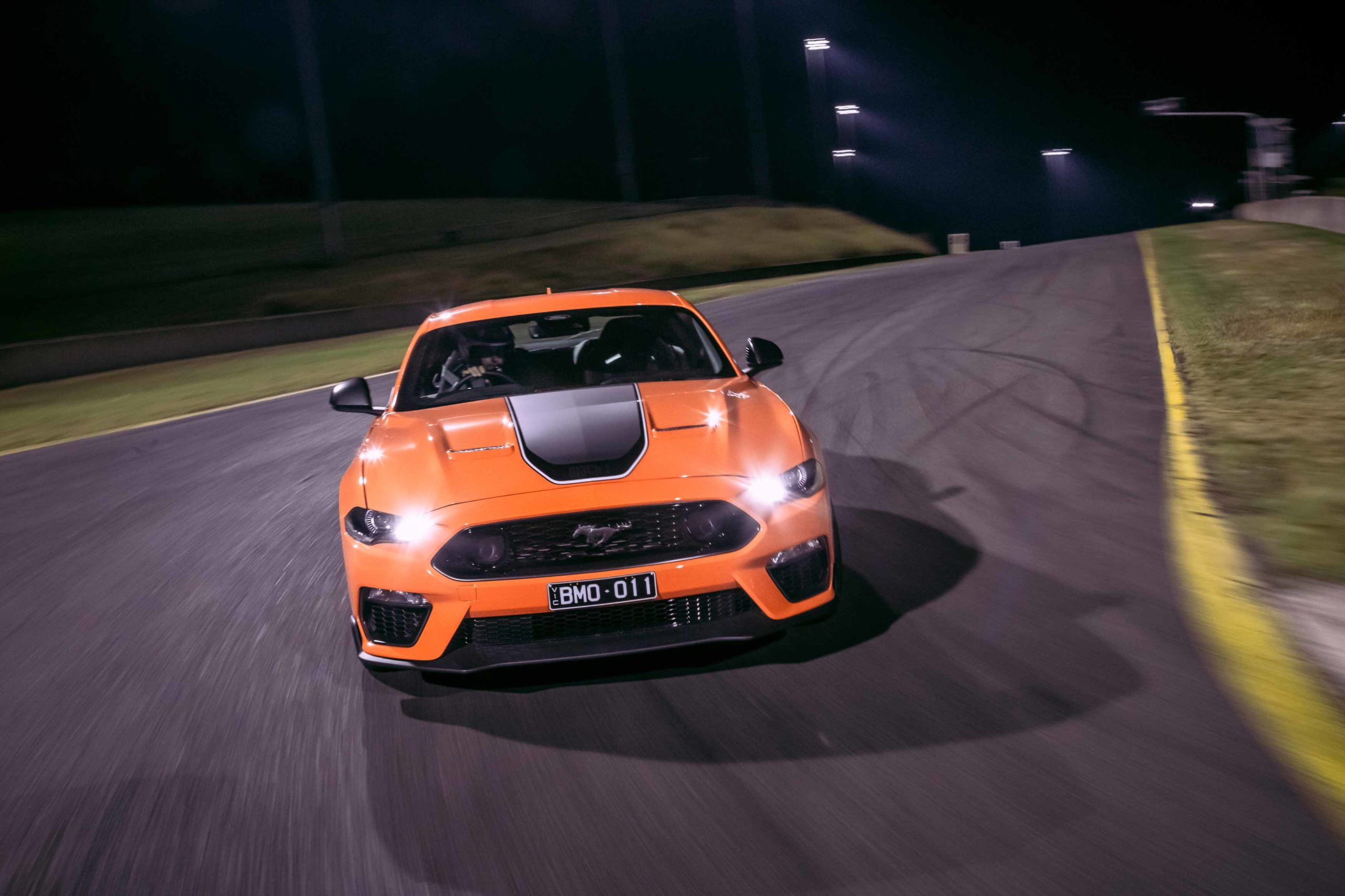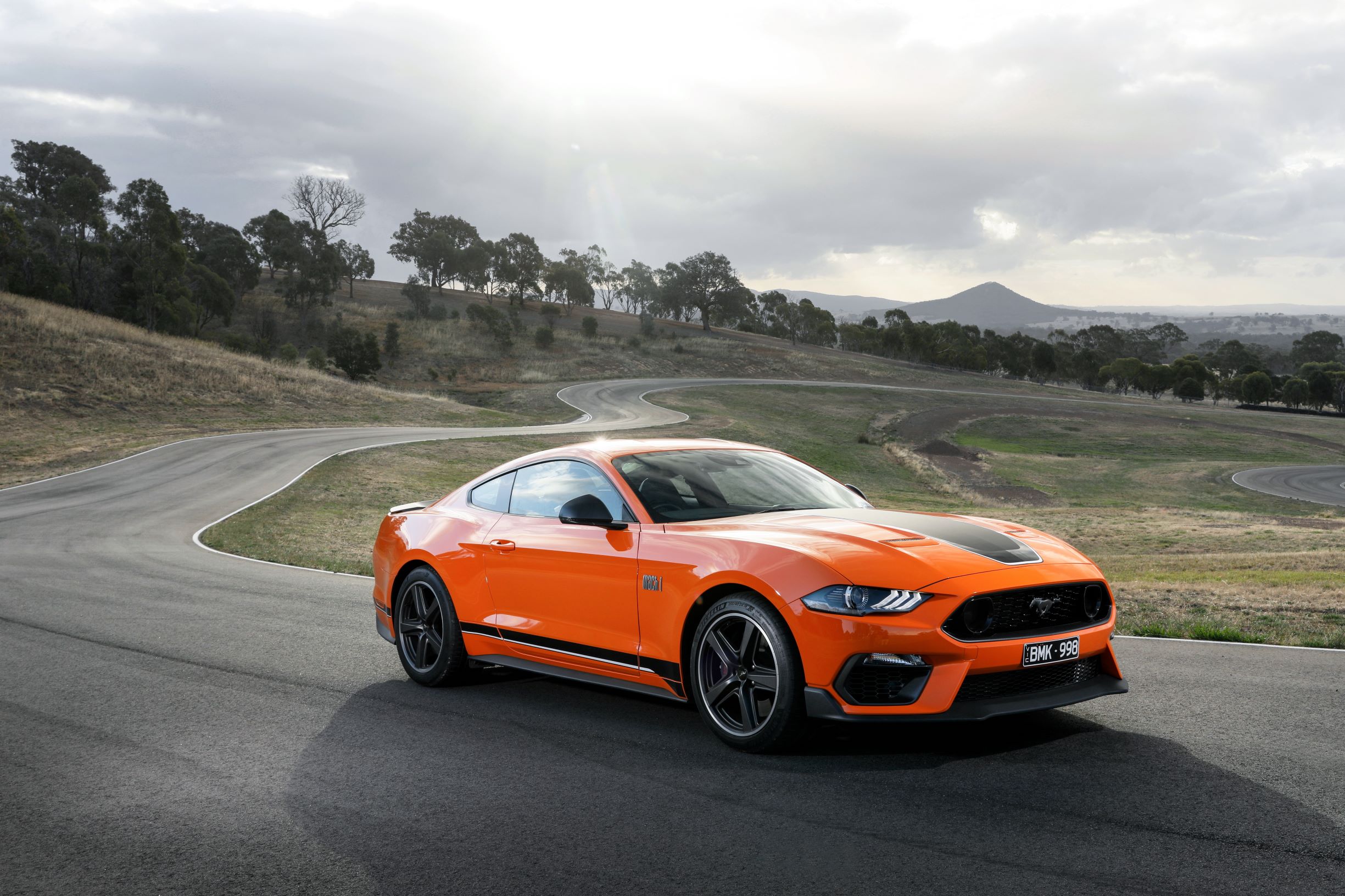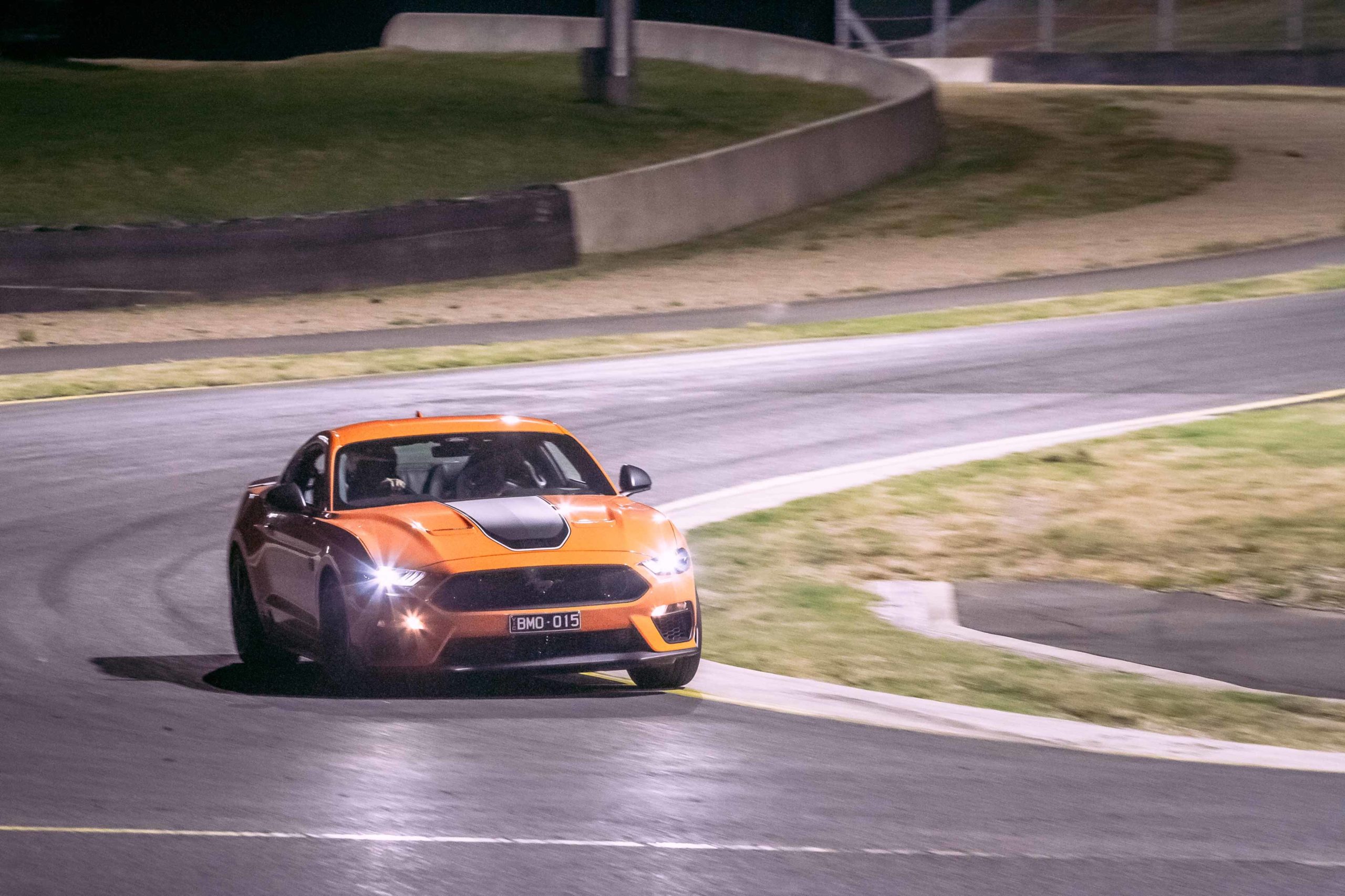
What is it?
Exactly what Ford said it would be – the most track-capable Mustang yet. The blue oval promised that the Mach 1 would elevate the famous pony car’s performance on the racetrack, adding several key elements of the US-only Shelby GT350 and GT500 for more grunt and improved handling.
The Mach 1 name dates back to the late 1960s, when it was introduced as a special edition to bridge the gap between the ‘regular’ Mustang range and the race-proven Shelby variants. This modern interpretation serves much the same purpose, at least in the USA where the Shelbys are sold. Here it will be the effective range-topper with very few R-Spec still available in near-new condition, giving the company another hero model to keep the car fresh before the new model arrives in the next 18-24 months.
Does it have any racing pedigree?
The Mustang has been synonymous with motorsport since its earliest days – and still is. Not only is it Ford’s car of choice for the Supercars series but it also carries the blue oval flag in NASCAR’s Cup Series and there’s a factory-built GT4 version.

This is also as close as Australian buyers are likely to get to a factory-approved Shelby model, given the number of key components used. Carroll Shelby was obviously famous for his racing career and his race-prepped versions of the Mustangs back in the ‘60s which spawned the famous road-going hot rods.
What’s under the bonnet?
The Mach 1 sticks with the same 5.0-litre V8 as the Mustang GT, but thanks to some minor tweaks that help it breathe better (specifically a new open-air induction system, intake manifold and new throttle bodies from the GT350) power is up to 345kW. That’s a small improvement over the 339kW in the GT, while torque remains the same at 556Nm.

Compared to the 552KW/830Nm that the R-Spec makes, the Mach 1 doesn’t look so good on paper, but this isn’t about being the fastest Mustang, it’s goal was to be the best to drive so the focus and development went into the handling.
Still, it’s a cracking engine and thanks to new parts and a recalibration of the software it has what Ford describes as a “reward-to-rev character” – which, put another way, means it revs more freely and peak power doesn’t kick in until 7500rpm so you can keep your foot buried until the redline and enjoy listening to its V8 scream.
It sounds better than the GT too, thanks to a unique tune for the active exhaust and new 4.5-inch exhaust tips. Another reason to keep your foot down and let the revs rise.
The engine is paired to your choice of a six-speed manual or 10-speed automatic gearbox.
The manual is the same Tremec unit used in the GT350 and has two new features in the Mach 1. The first is the ‘auto blip’ on the downshifts, with the car’s computer giving the engine a rev as you down-change for a smooth shift. The second is the ability to ‘flat shift’, which means you can keep your right foot down when you change up gears. It’s a strange sensation to stick the clutch in and pull another gear with your right foot buried, but once you get used to it it’s a great tool for a faster lap time.

As much fun as the manual ‘box is, the automatic does a good job, arguably impressing more on the track than the road. With so many ratios to choose from and with the modern pressure for fuel economy improvements left to its own devices the auto heads for the tallest gear as quickly as possible. It will happily cruise at 100km/h in 10th gear, and will even head there when you slot the gear lever into ‘Sport’ mode. On the track you can tap the paddle on the back of the steering wheel and lock it into manual mode. When using the paddle-shifters it does a good job of holding gears, and because it has more ratios it feels more flexible across the middle of the revs to better suit the tight layout of track we used. Having said that, the down shifts could be sharper and faster for a track car.
How does it handle?
This is where the Mach 1 really comes into its own, the work by the Ford Performance engineers was focused on making it turn corners better and that becomes obvious when you do get it on track.

In addition to sampling it on the road, Ford Australia took us to Sydney Motorsport Park for several runs around the ‘Amaroo’ layout. This is the version of the circuit that uses the Corporate Hill section with the more recently added extension included. While it make look too tight and technical on paper to really suit a big muscle car like the Mustang, in reality it was the ideal setting to show off its much improved handling.
There are a significant number of changes both on the surfaces and underneath for the Mach 1 that help make it so much better to drive on track.
Starting with the parts you can see, there’s a new grille with a 3D mesh design, low-gloss black ‘pony’ badge and a pair of round recesses that call back to the extra fog lights fitted to the 1970 edition of the Mach 1. While that helps give it a throwback look, the lower bumper is all business. It features a new splitter and lower grille that helps add more downforce as well as extra cooling. It’s not just the front either, at the back of the car Ford has fitted the same rear diffuser used on the GT500 for improved aerodynamics, and there’s a unique rear spoiler on the bootlid.
All up Ford claims the Mach 1 has 22 per cent more downforce than the standard Mustang GT.

And that’s only the beginning.
Underneath there’s an extended undertray (it’s 50cm longer than the one on the GT) to not only further enhance the aerodynamic performance – Ford claims its the biggest single element to help – but it also has fins to guide cool air onto the brakes (six-piston Brembos with 380mm rotors up front).
Ford raided the Shelby parts room to upgrade the suspension, adding GT350 toe-link components and the GT500 rear subframe, which features stiffer bushings. There’s also MagneRide adaptive dampers with a unique Mach 1 tune, stiffer anti-roll bars front and rear as well as new front springs that help the handling and the look, by lowering the ride height by 5mm.
Ford also improved the steering feel by giving the electric set-up a new tune that helps it feel more direct and responsive.
The Mach 1 rides on wide wheels (which feature a look designed to remind you of the ‘Magnum 500’ rims of the ‘70s) wrapped in Michelin Pilot Sport 4 rubber (the same as the GT). The 19-inch rims are 9.5-inches wide at the front and 10-inches wide at the rear for a bigger footprint on the road or track.
The 19-inch alloy wheels are an inch wider than those on the Mustang GT and feature a design that harks back to the original’s ‘Magnum 500’ that became a muscle car staple in the ‘70s in the US.
Going fast is one thing, staying fast is another. So Ford’s engineers also worked to ensure the Mach 1 had sufficient cooling to withstand repeated track laps. To that end there are side heat exchangers fitted to cool the engine oil and transmission oil, as well as a cooler for the rear axle; to keep the limited slip diff under control.
So what do all these changes mean when you get the Mach 1 on track? Well, it achieves the goal Ford set for itself by being the most impressive Mustang we’ve driven on track.

We were able to sample the Mach 1 and GT back-to-back and the improvements were many and obvious. The way the Mach 1 turns into corners is clearly superior to the standard ‘Stang, with more direct feel, better response and the ability to slide the car with ease and confidence.
It feels like a sharper, more resolved car than the regular version, with the changes elevating it beyond a retro-styled cruiser and into the realm of a car you could track often and with gusto.
Flat-shifting down the straights, the engine pulls strong and sounds great, and jumping on the brakes results in equally strong stopping power as the Brembos do their job; the extra cooling was obvious during our track session, as the brakes never felt soft despite repeated heavy use.
Turning into the corner the long bonnet of the Mustang goes more precisely where you point it and you can manipulate it more easily than you can in the GT.
The Mach 1 is simply a better version of the Mustang.
Where would you most like to drive it?
We were lucky enough to drive the Mach 1 on track as part of the launch, taking to Sydney Motorsport Park under lights. While the Amaroo layout, with its snaking extended layout, demonstrated the ease with which the Mach 1 changes direction, our mind couldn’t help but wander to the thought of taking the car on the main Gardner layout.
That would allow us to really stretch the legs of the V8 down the main straight, test the downforce through turn one and lean on the brakes at turn two. It would also provide more high speed corners which the Mach 1 would feel even more at home in.
What’s the interior like?
There’s an old-school charm to the Mustang’s design, but there’s also not a lot about the interior of the Mach 1 that’s unique. Each customer will get a small plaque to let them know they’ve bought a limited edition model, but the rest of the interior is largely what you’ll find in the GT, or R-Spec for that matter.

The 12-inch digital instrument panel is nice, it adds a hi-tech look to an otherwise retro cabin, while still offering practical benefits with its adjustable display. Ford’s SYNC3 infotainment system is easy to use and the 12-speaker B&O sound system is a premium touch.
The Mach 1 can be optioned with Recaro sports seats, which are both comfortable and stylish, but add $3000 to the bill. The only unique Mach 1 element is the white ‘cue ball’ gear-shifter in the manual (but you miss that on the auto).

The biggest bug bear remains the materials used in the cabin, with some of the switchgear feeling just plain cheap. Unfortunately that was never going to change on this generation but hopefully Ford is listening and will rectify for the next model.
Is it good value for money?
The Mach 1 is priced from $83,365 (plus on-road costs) and that’s for either the manual or automatic. That slots it almost precisely between the $64,190 GT and the R-Spec at $99,616; although, as mentioned earlier the R-Spec is almost gone and hard to find at that price anymore.

That puts the Mach 1 in clear space compared to any similar rear-wheel drive coupe. In terms of price the closest competition is arguably the BMW M240i Coupe (from $81,900) or Toyota Supra (from $87,126).
Would I buy one?
It’s the pick of the Mustang range. As impressive as the R-Spec is, and it does pack a lot more punch under the bonnet, I prefer the sharpness of the Mach 1.
It’s a genuinely engaging and fun car to drive, which the Mustang GT already was, but because it handles with more precision it raises the level of enjoyment to a new level.

2021 Ford Mustang Mach 1 price and specifications
| Price: | From $83,365 plus on-road costs |
| Engine: | 5.0-litre V8 petrol |
| Power: | 345kW at 7500rpm |
| Torque: | 556Nm at 4600rpm |
| Transmission: | Six-speed man or 10-speed auto, rear-wheel drive |
| Fuel use: | 13.9L/100km (man), 12.4L/100km (auto) |
| Wheels: | 19-inch alloys |
| Tyres: | 255/40 R19 (front), 275/40 R19 (rear) |
| Length: | 4789mm |
| Width: | 1916mm |
| Height: | 1382mm |
| Weight: | 1779kg (man), 1801kg (auto) |
| 0-100km/h: | No claim |












Discussion about this post